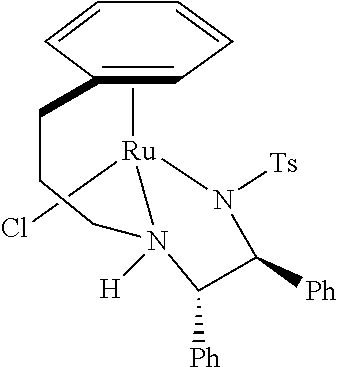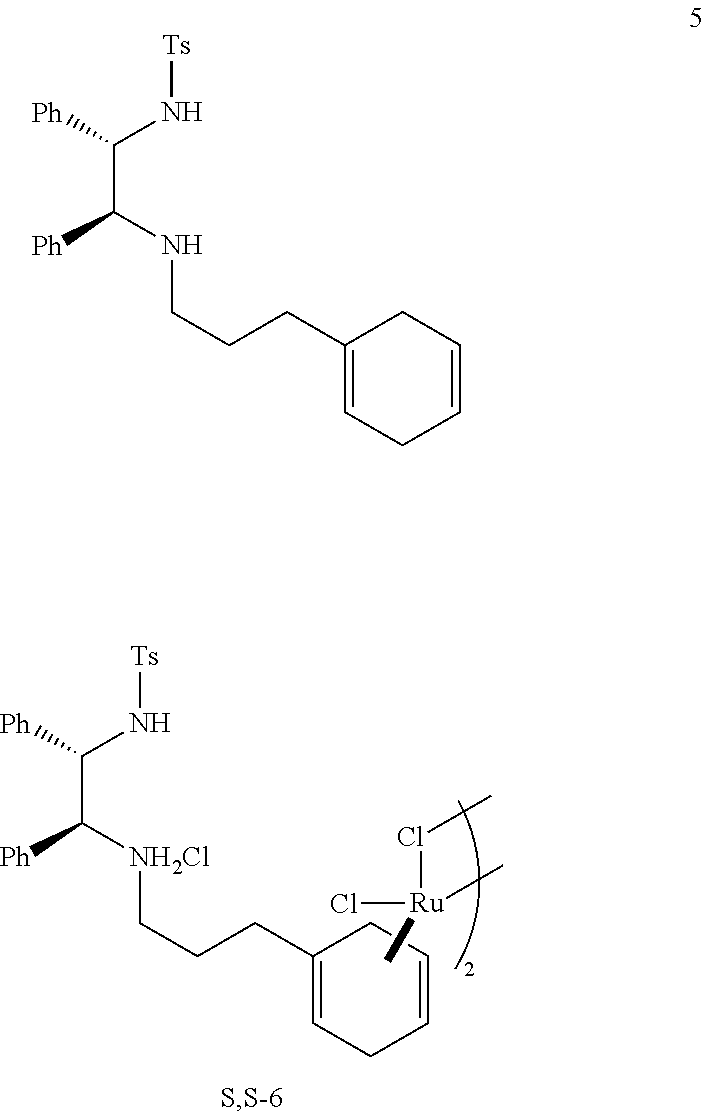Complexes and methods for their preparation
a technology applied in the field of complexes and complexes preparation, can solve the problems of contaminating by-products, complicating the subsequent purification of ligand precursors, and increasing the cost and complexity of preparing ligand precursors on a large scale, and achieves the effect of low cost and few impurities
- Summary
- Abstract
- Description
- Claims
- Application Information
AI Technical Summary
Benefits of technology
Problems solved by technology
Method used
Image
Examples
example 1
xa-1,4-dienyl-propionic acid
[0423]
[0424]3-Phenypropionic acid (3 g, 20 mmol) and t-BuOH (10.56 g) were placed to 250 mL round bottom flask equipped with magnetic stirrer and dry ice cooling finger. Flask was placed to Acetone / dry ice bath and 70 mL of ammonia were condensed into the flask. Lithium (1.23 g, 176 mmol, 8.8 eq.) was gradually added to the reaction flask. Reaction mixture was stirred at −78° C. for 5 hours and sat. NH4Cl (50 mL) was added to quench the reaction. Cooling was removed and the ammonia was left to evaporate. The residue was dissolved in water (100 mL) and pH was adjusted to 2-3 using 10% HCl. Product was extracted with t-BuOMe (3×50 mL), combined phases washed with brine (50 mL) dried over magnesium sulfate and solvent was evaporated to give the title compound as white solid (3.17 g, quant, 7% of starting material still present). δH (400 MHz, CDCl3) 5.65-5.60 (m, 2H, CH═CH), 5.40-5.38 (1H, m, C═CH), 2.65-2.49 (m, 4H, CH2), 2.46-2.39 (2H, m, CH2), 2.27-2.19 (2...
example 2
exa-1,4-dien-1-yl)butanoic acid
[0425]
[0426]4-Phenybutyric acid (3.28 g, 20 mmol) and t-BuOH (10.56 g) were placed to 250 mL round bottom flask equipped with magnetic stirrer and dry ice cooling finger. Flask was placed to Acetone / dry ice bath and 70 mL of ammonia were condensed into the flask. Lithium (1.23 g, 176 mmol, 8.8 eq.) was gradually added to the reaction flask. Reaction mixture was stirred at −78° C. for 5 hours and sat. NH4Cl (50 mL) was added to quench the reaction. Cooling was removed and the ammonia was left to evaporate. The residue was dissolved in water (100 mL) and pH was adjusted to 2-3 using 10% HCl. Product was extracted with t-BuOMe (3×50 mL), combined phases washed with brine (50 mL) dried over magnesium sulfate and solvent was evaporated to give the title compound as white solid (3.5 g, quant.). δH (400 MHz, CDCl3) 5.78-5.65 (m, 2H, CH═CH), 5.50-5.43 (1H, m, C═CH), 2.76-2.55 (m, 4H, CH2), 2.43-2.32 (2H, m, CH2), 2.10-1.97 (2H, m, CH2), 1.86-1.73 (2H, m, CH2);...
example 3
exa-1,4-dien-1-yl)propan-1-amine
[0427]
[0428]3-Phenylpropyl amine (2.76 g, 20 mmol) and EtOH (30 mL) were placed to 250 mL round bottom flask equipped with magnetic stirrer and dry ice cooling finger. Flask was placed to Acetone / dry ice bath (−78° C.) and ammonia (ca. 70 mL) was condensed into the flask. Lithium (1.23 g, 176 mmol, 8.8 eq.) was gradually added to the reaction mixture and mixture turned deep blue. After the blue colour disappeared, additional lithium was added (0.4 g, 57 mmol) flask. Reaction mixture was stirred at −78° C. for additional 1 hour during which the dark blue colour disappeared again. Sat. NH4Cl (50 mL) was added to quench the reaction. The cooling was removed and ammonia was allowed to evaporate. The remaining residue was dissolved in water (100 mL) and extracted with DCM (3×50 mL) Combined organic phases were washed with brine (50 mL) dried over magnesium sulphate and solvent was evaporated to give the title compound as colourless liquid (2.7 g, quant.). ...
PUM
 Login to View More
Login to View More Abstract
Description
Claims
Application Information
 Login to View More
Login to View More - R&D
- Intellectual Property
- Life Sciences
- Materials
- Tech Scout
- Unparalleled Data Quality
- Higher Quality Content
- 60% Fewer Hallucinations
Browse by: Latest US Patents, China's latest patents, Technical Efficacy Thesaurus, Application Domain, Technology Topic, Popular Technical Reports.
© 2025 PatSnap. All rights reserved.Legal|Privacy policy|Modern Slavery Act Transparency Statement|Sitemap|About US| Contact US: help@patsnap.com



